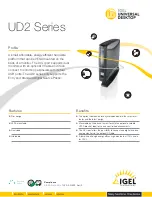
3. BIOS settings
The BIOS Setup program can be used to view and change the BIOS settings for the
computer. The BIOS Setup program is accessed by pressing the <F2> key after the
Power-On Self-Test (POST) memory test begins and before the operating system boot
begins. The following menus are available:
Menu Item
Purpose
Maintenance
Clears passwords and displays processor
information. The maintenance menu is displayed
only when the Desktop Board is in configure mode.
Manageability
Configure options associated with Intel® Platform
Administration Technology.
Main
Displays processor and memory configuration.
Advanced
Configures advanced features available through the
chipset.
Security
Sets passwords and security features.
Power
Configures power management features and power
supply controls.
Boot
Selects boot options.
Intel® ME
Configures options for the Intel® Management
Engine and Intel® Active Management Technology.
Exit
Saves or discards changes to Setup program
options.
For more information about the BIOS settings configuration we recommend
consulting Intel's® website (
www.intel.com
).
10





























